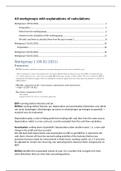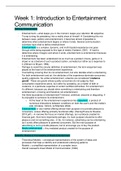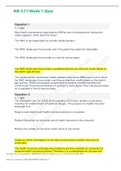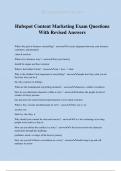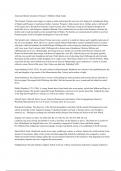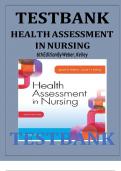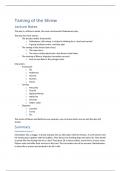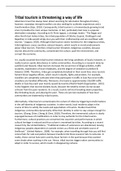All workgroups with explanations of calculations
Workgroup 1 (09.02.2021).....................................................................................................................1
Preparation.....................................................................................................................................1
Notes from the working group.......................................................................................................2
Answers to the calculation of this working group...........................................................................4
All ratio’s and how to calculate them from the quiz in week 1.......................................................8
Workgroup 2 (16.02.2021)...................................................................................................................10
Preparation......................................................................................................................................10
Workgroup 3 (23.02.2021)...................................................................................................................16
Workgroup 4 (02.03.2021)...................................................................................................................21
Workgroup 1 (09.02.2021)
Preparation
EBIT= earnings before interests and tax
EBITDA= earnings before interest, tax, depreciation and amortization (inkomsten voor aftrek
van rente, belastingen, afschrijvingen op activa en afschrijvingen op leningen en goodwill. =
maatstaf voor de brutowinst.
Depreciation plays a role in linking profit from trading with cash flow from the same source.
Depreciation, which is a non-cash cost, must be excluded from the cash flow calculation.
Amortization: writing down of goodwill (‘depreciation under another name’, i.e. a non-cash
charge in the profit and loss account).
We add back both depreciation and amortization to EBIT to get EBITDA. It represents the
cash that is thrown off from the normal trading activities of the business (before any
provision has been made for reinvestment in fixed assets, working capital, etc.). It may also
be adjusted for certain non-recurring, non-operating items that have been charged prior to
EBIT.
EBITDA identifies the sustainable stream of cash; it is a number that is largely free from
some distortions that can arise from accounting policies.
,Current ratio tussen de 1.2 en 1.8 duidt vaak op een gezond bedrijf: waarde >1 = meer
bezittingen die op korte termijn benut kunnen worden dan schulden die op korte termijn
afgelost moeten worden.
Notes from the working group
Non recurrent items:
- Re-evaluating
- Impairment of almost 50 million
- Less capital donations (6million)
Why is it important to figure them out?
They specify what kind of year it was
Why calculate the current ratio?
Short-term bills; can you pay this within a year? short-term liabilities
In this case it’s 134%, so it’s fine
EBITDA
Total comprehensive income: -88.702 euros
Add depreciation, amortisation and impairments (at operation expenses)
What is the reason for considering EBITDA?
What are the earnings, with everything away. Tax can differ between where you company is it’s
the core.
Depreciation a cashflow?
What other indicators are relevant?
Return on total assets you can benchmark it (each environment has it’s own benchmark and good
values). Hospital is a non-profit organisation
Long-term things:
Debt to equity ratio you look at the profit over certain years and not just this year
Absolute numbers and ratio’s
If you compare (benchmark) you have to make sure it’s on the same scale (size of the
organisation and other aspects etc.)
Assignment b:
Make an analysis one year ahead of the forecasted financial position and performance if this hospital
were to invest GBP 500 million in Buildings and equipment with an expected average live time of 25
years, financed by a long term loan of GBP 450 million bearing 3% interest and a redemption scheme
, of 20 years. Assess the impact on balance sheet, income statement and cash flows in the year of
investment and one year ahead.
Afschrijvingen: je lost je schuld af
Which parameters are going to change?
- Long-term liabilities up with 450 million (20 years of depreciation)
- Interest rate is going up (3%)
- Long-term assets is going up with 500 million (25 years of depreciation)
Impact on cash flow statement
- You see the depreciation in cash-flow
- Income: cash-flow the same, because you get an income each year through the depreciation
and you pay for the loan. More cash out-flow, than cash-in flow
- More equipment more production so maybe cash flow stays the same?
Current ratio stays the same (only non-current assets/liabilities goes up)
Current liabilities goes up (due to interest)
Income: it doesn’t necessarily needs to be a cash, can also be other incomes
Investment but they have gap of 50 million which they need to pay themselves.
Long-term liabilities are going to increase, the other side is also going to increase (long-term assets)
Cash on the current assets is decreased (you built the 50 million with it)
Comprehensive income statement:
What happens to your core business?
It might increase you production income, but maybe also your production expenses
Net-profit: earning after interest and taxes
How does this change compared to previous year: maybe decrease because you have to pay
more interest (3% more), and taxes (the more you have, the more taxes you need to pay)
EBITDA:
Depreciation is going up (from the buildings)
Cash-flow statement:
Difference in financing and investing cash-flow:
- Cash flow relating to the operating activities (salaries, personal expenses)
- Cash flow relating to the investing activities (purchasing a building)
- Cash flow relating to financing activities (financing the loan, paying it back + the interest)
revenue = DBC
So what happens if the hospital makes an investment?
- Operating cash-flows: none (it doesn’t directly affect personal expenses)
- Investing cash-flows: up with 500 million
- Financing cash-flows: 450 million loan + 3% interest + depreciation (20 years)
Workgroup 1 (09.02.2021).....................................................................................................................1
Preparation.....................................................................................................................................1
Notes from the working group.......................................................................................................2
Answers to the calculation of this working group...........................................................................4
All ratio’s and how to calculate them from the quiz in week 1.......................................................8
Workgroup 2 (16.02.2021)...................................................................................................................10
Preparation......................................................................................................................................10
Workgroup 3 (23.02.2021)...................................................................................................................16
Workgroup 4 (02.03.2021)...................................................................................................................21
Workgroup 1 (09.02.2021)
Preparation
EBIT= earnings before interests and tax
EBITDA= earnings before interest, tax, depreciation and amortization (inkomsten voor aftrek
van rente, belastingen, afschrijvingen op activa en afschrijvingen op leningen en goodwill. =
maatstaf voor de brutowinst.
Depreciation plays a role in linking profit from trading with cash flow from the same source.
Depreciation, which is a non-cash cost, must be excluded from the cash flow calculation.
Amortization: writing down of goodwill (‘depreciation under another name’, i.e. a non-cash
charge in the profit and loss account).
We add back both depreciation and amortization to EBIT to get EBITDA. It represents the
cash that is thrown off from the normal trading activities of the business (before any
provision has been made for reinvestment in fixed assets, working capital, etc.). It may also
be adjusted for certain non-recurring, non-operating items that have been charged prior to
EBIT.
EBITDA identifies the sustainable stream of cash; it is a number that is largely free from
some distortions that can arise from accounting policies.
,Current ratio tussen de 1.2 en 1.8 duidt vaak op een gezond bedrijf: waarde >1 = meer
bezittingen die op korte termijn benut kunnen worden dan schulden die op korte termijn
afgelost moeten worden.
Notes from the working group
Non recurrent items:
- Re-evaluating
- Impairment of almost 50 million
- Less capital donations (6million)
Why is it important to figure them out?
They specify what kind of year it was
Why calculate the current ratio?
Short-term bills; can you pay this within a year? short-term liabilities
In this case it’s 134%, so it’s fine
EBITDA
Total comprehensive income: -88.702 euros
Add depreciation, amortisation and impairments (at operation expenses)
What is the reason for considering EBITDA?
What are the earnings, with everything away. Tax can differ between where you company is it’s
the core.
Depreciation a cashflow?
What other indicators are relevant?
Return on total assets you can benchmark it (each environment has it’s own benchmark and good
values). Hospital is a non-profit organisation
Long-term things:
Debt to equity ratio you look at the profit over certain years and not just this year
Absolute numbers and ratio’s
If you compare (benchmark) you have to make sure it’s on the same scale (size of the
organisation and other aspects etc.)
Assignment b:
Make an analysis one year ahead of the forecasted financial position and performance if this hospital
were to invest GBP 500 million in Buildings and equipment with an expected average live time of 25
years, financed by a long term loan of GBP 450 million bearing 3% interest and a redemption scheme
, of 20 years. Assess the impact on balance sheet, income statement and cash flows in the year of
investment and one year ahead.
Afschrijvingen: je lost je schuld af
Which parameters are going to change?
- Long-term liabilities up with 450 million (20 years of depreciation)
- Interest rate is going up (3%)
- Long-term assets is going up with 500 million (25 years of depreciation)
Impact on cash flow statement
- You see the depreciation in cash-flow
- Income: cash-flow the same, because you get an income each year through the depreciation
and you pay for the loan. More cash out-flow, than cash-in flow
- More equipment more production so maybe cash flow stays the same?
Current ratio stays the same (only non-current assets/liabilities goes up)
Current liabilities goes up (due to interest)
Income: it doesn’t necessarily needs to be a cash, can also be other incomes
Investment but they have gap of 50 million which they need to pay themselves.
Long-term liabilities are going to increase, the other side is also going to increase (long-term assets)
Cash on the current assets is decreased (you built the 50 million with it)
Comprehensive income statement:
What happens to your core business?
It might increase you production income, but maybe also your production expenses
Net-profit: earning after interest and taxes
How does this change compared to previous year: maybe decrease because you have to pay
more interest (3% more), and taxes (the more you have, the more taxes you need to pay)
EBITDA:
Depreciation is going up (from the buildings)
Cash-flow statement:
Difference in financing and investing cash-flow:
- Cash flow relating to the operating activities (salaries, personal expenses)
- Cash flow relating to the investing activities (purchasing a building)
- Cash flow relating to financing activities (financing the loan, paying it back + the interest)
revenue = DBC
So what happens if the hospital makes an investment?
- Operating cash-flows: none (it doesn’t directly affect personal expenses)
- Investing cash-flows: up with 500 million
- Financing cash-flows: 450 million loan + 3% interest + depreciation (20 years)

